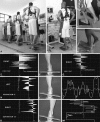Proprioceptive Training and Injury Prevention in a Professional Men's Basketball Team: A Six-Year Prospective Study
- PMID: 26203850
- PMCID: PMC4750505
- DOI: 10.1519/JSC.0000000000001097
Proprioceptive Training and Injury Prevention in a Professional Men's Basketball Team: A Six-Year Prospective Study
Abstract
Single limb stance instability is a risk factor for lower extremity injuries. Therefore, the development of proprioception may play an important role in injury prevention. This investigation considered a professional basketball team for 6 years, integrating systematic proprioceptive activity in the training routine. The purpose was to assess the effectiveness of proprioceptive training programs based on quantifiable instability, to reduce ankle sprains, knee sprains, and low back pain through developing refined and long-lasting proprioceptive control. Fifty-five subjects were studied. In the first biennium (2004-2006), the preventive program consisted of classic proprioceptive exercises. In the second biennium (2006-2008), the proprioceptive training became quantifiable and interactive by means of electronic proprioceptive stations. In the third biennium (2008-2010), the intensity and the training volume increased while the session duration became shorter. Analysis of variance was used to analyze the differences in proprioceptive control between groups, years, and bienniums. Injury rates and rate ratios of injury during practices and games were estimated. The results showed a statistically significant reduction in the occurrence of ankle sprains by 81% from the first to the third biennium (p < 0.001). Low back pain showed similar results with a reduction of 77.8% (p < 0.005). The reduction in knee sprains was 64.5% (not significant). Comparing the third biennium with the level of all new entry players, proprioceptive control improved significantly by 72.2% (p < 0.001). These findings indicate that improvements in proprioceptive control in single stance may be a key factor for an effective reduction in ankle sprains, knee sprains, and low back pain.
Figures





References
-
- Arnold B, De la Motte S, Linens S, Ross SE. Ankle instability is associated with balance impairments: A meta-analysis. Med Sci Sports Exerc 41: 1048–1062, 2009. - PubMed
-
- Bahr R, Bahr IA. Incidence of acute volleyball injuries: A prospective cohort study of injury mechanisms and risk factors. Scand J Med Sci Sports 7: 166–171, 1997. - PubMed
-
- Calatayud J, Borreani S, Colado JC, Flandez J, Page P, Andersen LL. Exercise and ankle sprain injuries: A comprehensive review. Phys Sportsmed 42: 88–93, 2014. - PubMed
Publication types
MeSH terms
LinkOut - more resources
Full Text Sources
Other Literature Sources
Medical

